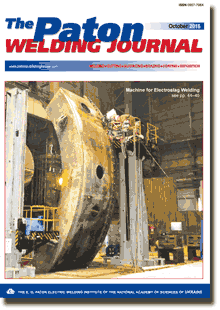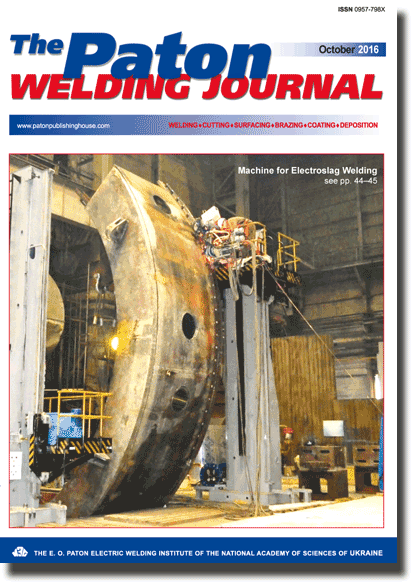| 2016 №10 (01) |
DOI of Article 10.15407/tpwj2016.10.02 |
2016 №10 (03) |

The Paton Welding Journal, 2016, #10, 8-13 pages
Comparison of influence of pulsed effects of magnetic and electric fields on stressed state of welded joints of aluminium alloy AMG6
L.M. Lobanov1, I.P. Kondratenko2, N.A. Pashchin1, O.L. Mikhoduj1 and A.V. Cherkashin1
1E.O. Paton Electric Welding Institute, NASU 11 Kazimir Malevich Str., 03680, Kiev, Ukraine. E-mail: office@paton.kiev.ua
2Institute of Electrodynamics, NASU 56 Pobedy Ave., 03680, Kiev, Ukraine
Abstract
The residual welding stresses negatively affect the fatigue limit of welded joint, being the main cause for brittle fracture of metal, i.e. corrosion cracking. Therefore, the development of effective methods for control of welding stresses, characterized by low energy consumption and relatively simple realization, is traditionally an urgent problem for modern production. At the present time the methods for reducing welding stresses became widespread, based on the influence of pulses of electric current and magnetic field. Moreover, each of the methods has its advantages and disadvantages, and evaluation of their efficiency in the control of residual welding stresses represents an urgent problem. In the work the comparative evaluation of efficiency of control of residual stresses of AMg6 alloy of welded plates was carried out at treatments by pulsed electromagnetic field (TPEMF) and pulsed current (EDT), applying planar inductors. Using the method of electron speckle interferometry it was revealed that TPEMF and EDT reduce the initial level of welding stresses in the zone of pulsed effects to 100 %. 16 Ref., 1 Table, 4 Figures.
Keywords: electrodynamic and magnetic pulse treatment, aluminium alloy, welded joint, electron speckle interferometry, efficiency of treatment, residual stresses, electroplastic effect, current density, planar inductor
Received: 30.06.16
Published: 23.10.16
References
- Trufyakov, V.I. (1973) Fatigue of welded joints. Kiev: Naukova Dumka.
- Trufyakov, V.I., Mikheev, P.P., Kuzmenko, A.Z. (1980) Influence of scale factors and residual welding stresses on rate of fatigue crack propagation. Problemy Prochnosti, 6, 20–22, 30.
- Petuchkov, V.G., Kudinov, V.M., Fadeenko, Yu.I. (1993) Explosion treatment of welded joints of metal structures. Moscow: Metallurgiya.
- Antonov, Yu.A., Ragozin, Yu.I. (2001) Pulse method of residual stress relieving. Fizika i Khimiya Obrab. Materialov, 3, 91–95.
- Tang, F., Lu, A.L., Mei, J.F. et al. (1998) Research on residual stress reduction by a low frequency alternating magnetic field. of Materials Processing Technology, 74, 255–258. https://doi.org/10.1016/S0924-0136(97)00279-3
- Stepanov, G.V., Babutsky, A.I. (2007) Modeling of stress relaxation under action of high density pulse current. Problemy Prochnosti, 2, 113–120.
- Lobanov, L., Pashchin, N., Pivtorak, V. et al. (2014) Application of local current pulses for determination and control of residual stresses. Advanced Materials Research, 996, 386–391. https://doi.org/10.4028/www.scientific.net/AMR.996.386
- Stepanov, G.V., Babutsky, A.I., Mameev, I.A. et al. (2011) Redistribution of residual welding stresses due to treatment by pulse electromagnetic field. Problemy Prochnosti, 3, 121–131.
- Baranov, Yu.V., Troitsky, O.A., Avramov, Yu.S. (2001) Physical principles of electroplastic treatment and new materials. Moscow: MGIU.
- Lobanov, L.M., Pashchin, N.A., Cherkashin, A.V. et al. (2012) Efficiency of electrodynamic treatment of aluminium alloy AMg6 and its welded joints. The Paton Welding J., 1, 2–6.
- UDK 658.562: Report (final) of research activity on project R 7.3.1: To develop the technology and equipment for prompt non-destructive determination of residual stresses in welded structures based on application of local current pulse and electron speckle interferometry. Nat. Registr. 011U003481. Kiev: PWI.
- Lobanov, L.M., Pivtorak, V.A., Savitsky, V.V. et al. (2006) Procedure for determination of residual stresses in welded joints and structural elements using electron speckle interferometry. The Paton Welding J., 1, 24–29.
- Kravchenko, V.Ya. (1966) Effect of directed electron flow on moving dislocations. Experimentalnoj i Teoreticheskoj Fiziki, 51, Issue 6(12), 1677–1688.
- Johnson, K. (1989) Mechanics of contact interaction. Moscow: Mir.
- Lobanov, L.M., Pashchin, N.A., Mikhoduj, O.L. et al. (2012) Effectiveness of various variants of electrodynamic treatment of AMg6 alloy and its welded joints. The Paton Welding J., 12, 26–31.
- Troitsky, O.A., Kalymbetov, P.U. (1981) Dependence of electroplastic effect in zinc on isolated pulse duration. Fizika Metallov i Metallovedenie, 51(Issue 5), 1056–1059.
Suggested Citation
L.M. Lobanov, I.P. Kondratenko, N.A. Pashchin, O.L. Mikhoduj and A.V. Cherkashin (2016) Comparison of influence of pulsed effects of magnetic and electric fields on stressed state of welded joints of aluminium alloy AMG6. The Paton Welding J., 10, 8-13.The cost of subscription/purchase order journals or individual articles
| Journal/Currency | Annual Set | 1 issue printed |
1 issue |
one article |
| TPWJ/USD | 384 $ | 32 $ | 26 $ | 13 $ |
| TPWJ/EUR | 348 € | 29 € | 24 € | 12 € |
| TPWJ/UAH | 7200 UAH | 600 UAH | 600 UAH | 280 UAH |
| AS/UAH | 1800 UAH | 300 UAH | 300 UAH | 150 UAH |
| AS/USD | 192 $ | 32 $ | 26 $ | 13 $ |
| AS/EUR | 180 € | 30 € | 25 € | 12 € |
| SEM/UAH | 1200 UAH | 300 UAH | 300 UAH | 150 UAH |
| SEM/USD | 128 $ | 32 $ | 26 $ | 13 $ |
| SEM/EUR | 120 € | 30 € | 25 € | 12 € |
| TDNK/UAH | 1200 UAH | 300 UAH | 300 UAH | 150 UAH |
| TDNK/USD | 128 $ | 32 $ | 26 $ | 13 $ |
| TDNK/EUR | 120 € | 30 € | 25 € | 15 € |
AS = «Automatic Welding» - 6 issues per year;
TPWJ = «PATON WELDING JOURNAL» - 12 issues per year;
SEM = «Electrometallurgy Today» - 4 issues per year;
TDNK = «Technical Diagnostics and Non-Destructive Testing» - 4 issues per year.


